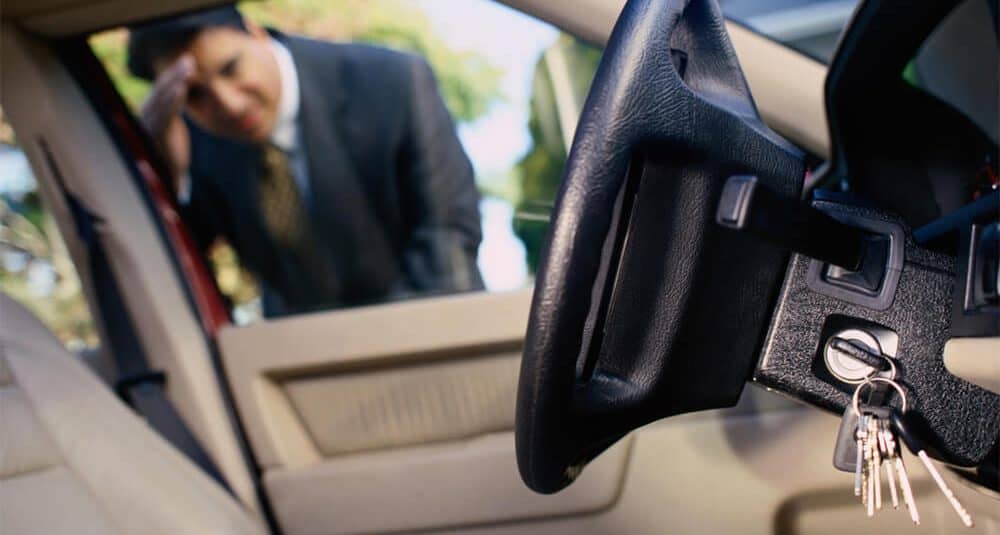It’s a situation that many drivers dread: locking their keys in the car. It can be inconvenient, frustrating, and even downright embarrassing.
However, knowing what to do in this scenario can alleviate some of the stress and help you resolve the issue quickly and efficiently.
In this comprehensive guide, we’ll discuss various options you have when you find yourself locked out of your vehicle, from calling for professional help to trying DIY methods.
We’ll also cover preventative measures you can take to avoid this predicament in the future.
Stay calm and assess the situation
First and foremost, stay calm. Panicking will only make the situation worse and cloud your judgment. Take a deep breath and remind yourself that you can resolve the situation.
Start by assessing the situation – are you in a safe location?
If not, move to a safer spot while you figure out your next steps. Ensure your car is in a secure position (i.e., in park with the handbrake on) to prevent any further complications.
Confirm the keys are indeed locked inside
Before you take any action, double-check that the keys are truly locked inside the vehicle. Inspect all doors and windows, as well as the boot, to make sure they are indeed locked.
Sometimes a door may be left unlocked, or a window may be open enough for you to retrieve your keys without additional assistance.
Check for a spare key
If you have a spare key at home or with someone you trust, now is the time to use it. Arrange for someone to bring the key to you or find a way to retrieve it yourself.
Keep in mind that this may not be the fastest solution, but it can save you the cost of calling a professional.
Call for professional assistance
Roadside assistance
If you have a membership with a roadside assistance provider, such as the AA or RAC, call them for help. They have trained professionals who can unlock your car without causing damage.
Most providers include lockout services in their membership packages. Be prepared to provide your membership information, location, and vehicle details.
Automotive locksmith
If you don’t have roadside assistance or prefer a different approach, you can call an automotive locksmith.
These professionals specialize in unlocking vehicles and can help you regain access to your car. Look for a reputable locksmith in your area, and make sure to ask for an estimate before they begin work.
Keep in mind that costs can vary, so it’s essential to get a clear understanding of the fees upfront.
DIY methods to unlock your car
If you’re feeling confident and have some basic tools at hand, you can try unlocking your car yourself. Keep in mind that using these methods may cause damage to your vehicle, so proceed with caution.
Shoestring method
This method is most effective on cars with pull-up locking mechanisms. Tie a slipknot in a shoestring or a piece of string. Work the string into the door through the gap between the door and the window, maneuvering the slipknot around the lock.
Pull the string tight to close the knot around the lock and pull upwards to unlock the door. Be patient and gentle with this method, as it may take several attempts to get the knot around the lock.
Coat hanger method
Straighten out a wire coat hanger, leaving a hook at one end. Carefully slide the hooked end between the door and the window, aiming to hook the lock mechanism.
Once you’ve hooked the lock, pull upwards to unlock the door. This method may not work on all vehicles, especially those with complex locking systems.
Inflatable wedge and probe method
Using an inflatable wedge or a small airbag, create a small gap between the door and the window frame. Insert the wedge carefully to avoid damaging the window or door.
Once the gap is large enough, use a long, thin probe (such as a straightened coat hanger) to reach inside the vehicle and either press the unlock button or manipulate the locking mechanism.
Rod and screwdriver method
This method requires more caution, as it can potentially cause damage to your vehicle. Use a flathead screwdriver to gently pry the top corner of the door away from the frame.
Insert a long, thin rod (such as an antenna or a slim metal rod) into the gap and attempt to press the unlock button or manipulate the lock. Be careful not to damage the door or window during this process.
Preventative measures
To avoid locking your keys in your car in the future, consider taking the following preventative measures:
Keyless entry system
Invest in a keyless entry system that allows you to unlock your car with a code or a remote. This can reduce the likelihood of accidentally locking your keys inside your vehicle.
Hide-a-key
Purchase a hide-a-key device that attaches to your car with a strong magnet. Place a spare key inside the device and secure it in a hidden location on your vehicle’s exterior.
Be cautious about where you place the device, as it could be discovered by potential thieves.
Spare key with a trusted person
Leave a spare key with a trusted family member, friend, or neighbour. If you lock your keys in your car, you can contact them for assistance.
Smartphone applications
Consider using a smartphone app that allows you to lock and unlock your vehicle remotely. Many car manufacturers offer apps with this feature, which can help prevent lockouts.
Conclusion
Locking your keys in your car can be a frustrating and inconvenient experience. However, by staying calm and assessing your options, you can resolve the situation quickly and efficiently.
Whether you choose to call for professional assistance or attempt a DIY method, remember to be cautious and patient.
Additionally, consider implementing preventative measures to reduce the risk of future lockouts.
With the right knowledge and tools at your disposal, you’ll be prepared to handle this common predicament with ease.

